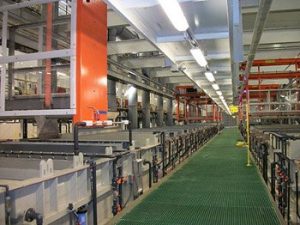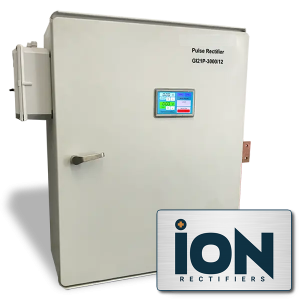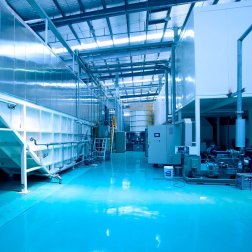 Metal finishing is an essential step in the metal manufacturing industry, enhancing the durability, appearance, and corrosion resistance of metal parts. Two popular methods of metal finishing are anodizing and nickel plating. Both processes offer unique benefits and are suitable for different applications. In this blog post, we’ll delve into the details of the anodizing and nickel plating processes, compare their advantages, and explore the types of metal parts commonly coated. We’ll also touch upon anodizing dye colors, the equipment used by anodizing companies, the importance of cleaning metal surfaces, and proper wastewater management.
Metal finishing is an essential step in the metal manufacturing industry, enhancing the durability, appearance, and corrosion resistance of metal parts. Two popular methods of metal finishing are anodizing and nickel plating. Both processes offer unique benefits and are suitable for different applications. In this blog post, we’ll delve into the details of the anodizing and nickel plating processes, compare their advantages, and explore the types of metal parts commonly coated. We’ll also touch upon anodizing dye colors, the equipment used by anodizing companies, the importance of cleaning metal surfaces, and proper wastewater management.
Anodizing Metal Finishing Process
Anodizing is an electrochemical process that increases the thickness of the natural oxide layer on the surface of metal parts, primarily aluminum. This enhanced oxide layer improves corrosion resistance, durability, and provides a decorative finish. The anodizing process involves immersing the metal part in an electrolytic solution and passing an electric current through it, causing the metal to oxidize.
Anodizing Dye Colors and Equipment
One of the appealing features of anodizing is the variety of dye colors available for achieving different aesthetic finishes. Common anodizing dye colors include black, blue, red, gold, and green, among others. The anodizing equipment for sale ranges from simple DIY kits to sophisticated industrial setups. Professional anodizing companies use specialized equipment, such as polypropylene tanks, ac to dc plating rectifiers, and controller stations, to ensure consistent and high-quality results.
Nickel Plating Process
Nickel plating is a metal finishing process that involves depositing a layer of nickel onto the surface of a metal part to enhance its appearance, corrosion resistance, and wear resistance. The nickel plating process can be performed using either electrolytic or electroless methods. Electrolytic nickel plating requires an electric current to deposit the nickel layer, while electroless nickel plating uses a chemical reaction to achieve the plating.
Benefits of Anodizing vs. Nickel Plating
Anodizing:
Corrosion Resistance: Anodized parts have excellent resistance to corrosion, making them ideal for outdoor and marine applications.
Decorative Finishes: A wide range of anodizing dye colors allows for customizable and aesthetically pleasing finishes.
–Durability: The anodized layer is integral to the metal, providing a durable and long-lasting finish.
Nickel Plating:
Wear Resistance: Nickel-plated parts offer superior wear resistance, making them suitable for mechanical components.
Smooth Finish: Nickel plating provides a smooth and lustrous finish that enhances the appearance of the metal part.
Electrical Conductivity: Nickel has excellent electrical conductivity, making it suitable for electronic and electrical applications.
Types of Metal Parts Commonly Coated
Both anodizing and nickel plating processes are used to coat a variety of metal parts, including:
Automotive Parts: Engine components, trim, and wheels.
Aerospace Components: Aircraft parts, fasteners, and hydraulic fittings.
Consumer Goods: Electronics, appliances, and jewelry.
Industrial Equipment: Pumps, valves, and machinery components.
The choice between anodizing and nickel plating depends on the specific requirements of the application, such as corrosion resistance, wear resistance, and aesthetic preferences.
Importance of Cleaning Metal Surfaces
Before undergoing a metal finishing process, it is crucial to clean the metal surfaces thoroughly to remove any contaminants, oils, or residues. Proper cleaning ensures better adhesion of the anodizing or nickel plating layer, resulting in a more durable and high-quality finish. Use of a paint stripper for metal or specialized cleaning solutions can effectively remove stubborn contaminants and prepare the metal surface for the finishing process.
Handling Wastewater Properly
Wastewater generated during the anodizing and nickel plating processes contains various chemicals and metals, which can be harmful to the environment if not properly treated and disposed of. Conducting a jar test for wastewater helps in determining the appropriate treatment method to remove contaminants and ensure compliance with environmental regulations. Proper wastewater management is essential to minimize environmental impact and maintain sustainability in metal finishing operations.
A Brite Company: Your Trusted Supplier for Metal Finishing Equipment
If you are looking to become an independent sales rep for A Brite Company, a leading supplier of metal finishing equipment and supplies, now is the perfect time! A Brite Company offers a comprehensive range of anodizing equipment for sale, including tanks, rectifiers, controllers, and anodizing supplies, as well as nickel plating equipment and solutions. With a reputation for quality and innovation, the A Brite Company is committed to providing the best plating equipment manufacturers can buy to meet the diverse needs of the metal finishing industry.
In summary, both anodizing and nickel plating are effective metal finishing processes that offer unique benefits and are suitable for different applications. The choice between the two processes depends on the specific requirements of the application, such as corrosion resistance, wear resistance, and aesthetic preferences. Proper cleaning of metal surfaces prior to undergoing a metal finishing process and handling wastewater responsibly are essential steps to ensure quality and sustainability in metal finishing operations.
A Brite Company is a top supplier of metal finishing equipment and supplies, and the company is looking to grow their sales network. If you are interested in becoming an independent sales rep for A Brite Company we encourage you to visit this careers page.








 In the intricate world of metal finishing, access to quality
In the intricate world of metal finishing, access to quality 


